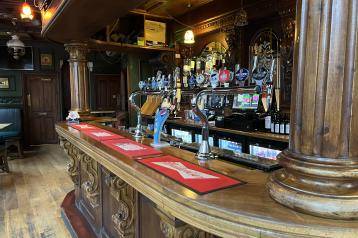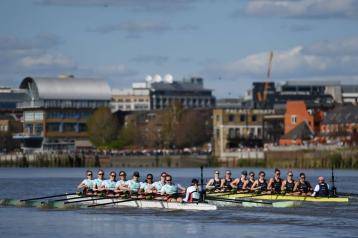
French sailors, soldiers and merchantmen signing with the Free French forces at Olympia. PICTURE: IMPERIAL WAR MUSEUM
Sunday (9 May) is Europe Day when we celebrate peace and unity in Europe. It's also an opportunity to reflect on our centuries-old partnership and its many local expressions.
Europeans have profoundly influenced every aspect of our lives today, from the arrival of Christianity from Rome in the sixth century and all great British literature (Milton, Shakespeare, the Romantic poets, Dickens, the list goes on) to how we speak and what we eat.
Nowhere epitomises that partnership more than Hammersmith & Fulham, where, in 1944, the defeat of Nazism and the liberation of mainland Europe was planned in what is today Colet Court.
The borough was also the wartime base for the Free French army led by General de Gaulle, which used Olympia as its main depot and mustering centre, as well as for the Free Polish intelligence service which played a major role in allied intelligence-gathering operations across continental Europe and North Africa.
The Polish Intelligence Service made an invaluable contribution to the planning and successful execution of the invasion and to the ultimate victory of the allied forces in Europe." – Cdr. Dunderdale, head of Special Liaison Control (SLC)
Had it not been for the magnificent [work of] the Polish squadrons and their unsurpassed gallantry, I hesitate to say that the outcome of the Battle [of Britain] would have been the same." – Air Officer Commanding Hugh Dowding
Of course, European military alliances had been shaping and reshaping the continent for centuries long before World War Two. The Dutch Navy helped England defeat the Spanish Armada, the Austrian, Prussian and Russian armies helped Britain defeat Napoleon. World War One could not have been won without the French, nor World War Two without the Russians.
Today, those centuries of shared history and cultural exchange and decades of free movement across the continent mean that around 35,000, or one in five, of Hammersmith & Fulham's residents are EU citizens. It is home to large Italian, French, Spanish, Polish and Irish communities as well as people from Portugal, Greece, Romania, Germany, Sweden, Holland and indeed every other European nation.
It is also home to many large European companies, including some of the borough's biggest employers like L'Oréal, Net-a-Porter, Endemol, Ericsson Media Services and Accor UK – Novotel, not to mention the myriad of small and medium-sized businesses in the borough that rely on their EU workforce.

The Irish Cultural Centre opened in 1995 to serve Hammersmith's large Irish community – the third largest as a proportion of the population in England and Wales – and the wider community.
The Polish Social and Cultural Centre (POSK) – an important cultural hub for London's post-war Polish migrants, the Solidarity Generation of the 1980s and those who arrived after the EU expanded in 2004 – opened here in 1974.
They are both still right at the heart of Hammersmith's diverse community today, with regular exhibitions, educational events and concerts as well as voluntary community work.
The personal stories of some of those who came to the UK as a result of World War Two illustrate our close ties, but our shared heritage and our interwoven history goes back much further.
Alf Dubs, now a member of the House of Lords and a Hammersmith resident, arrived in the UK aged six in 1939 on the Kindertransport from Prague, one of 669 mainly Jewish children whose lives were saved by Nicholas Winton. Alf is a lifelong campaigner for human rights and was part of the Government team that negotiated the Good Friday Agreement and peace in Northern Ireland.
My mother was Austrian, my father was from Bohemia. I am Czech by birth, proudly British by choice and I also feel profoundly European. I believe the love and commitment a refugee feels for the country that saved them is powerful and enduring. I hope in my own small way that I have tried to repay that debt to Britain." – Alf Dubs

Prof. Roman Ludwik Wajda (1901-1974) was a Polish engineer, academic and decorated war hero who fought at the battle of Monte Cassino. After arriving in the UK in 1946 he became a great promoter of Polish culture and supporter of the Polish community in the UK. He taught Polish at University College London and at Battersea College of Technology and in 1964 he began to raise funds to build a Polish Centre in Hammersmith. He was the first Chairman of Hammersmith's Polish Social and Cultural Association (POSK) which finally opened in 1974, on King Street, three weeks after he died. He is buried in Putney.
Lucie Aubrac, born in France in 1912, became a history teacher-turned-Resistance heroine who outwitted the Gestapo, rescued her husband (more than once) from captivity, became the first female French parliamentarian in 1944 and was awarded France's highest military accolade – the Legion of Honor – in 1996 for her role in the French Resistance.

She and her husband were evacuated to Britain in February 1944 and just a few days later Lucie gave birth to their daughter, Catherine, at Queen Charlotte's Hospital, Hammersmith.
Dating from 1739, Queen Charlotte's and Chelsea Hospital is one of the oldest maternity hospitals in Europe, and the first of its kind in Britain. Its name came from its patron, Queen Charlotte of Mecklenburg-Strelitz, the wife of George III.
Charlotte was born and raised in Germany.
Charlotte was a patron of the arts who invited Mozart to perform three times at Buckingham House and an amateur botanist who helped expand Kew Gardens.

Until 1999 Queen Charlotte's Hospital occupied a site on Goldhawk Road, Hammersmith. It is now located between East Acton and White City and shares a site with the Hammersmith Hospital. Daniel Radcliffe, the Thatcher twins, Sebastian Coe, Helen Mirren (who played queen Charlotte in the Madness of King George) and Benedict Cumberbatch were all born there.
Did you know?
Willy Brandt, then Mayor of West Berlin, a major figure in the modern history of Europe who later became Germany's Chancellor, visited the borough in 1963 with the gift of a lamp from a Berlin street. The lamp today stands in Furnivall Gardens in Hammersmith "as a token of friendship between the two communities". The gift marked the twinning of Hammersmith & Fulham with Berlin-Neukölln. Neukölln is also the name of a track on David Bowie's 1977 album "Heroes", written by David Bowie and Brian Eno while Bowie was living in Berlin.
The borough is also twinned with Anderlecht (Brussels), Boulogne-Billancourt (Paris), Montefiore Conca (Emilia-Romagna) and Zaandam (Amsterdam).
Ernest Hemingway, the Nobel prize-winning American author was a regular visitor to The Dove in Hammersmith when he lived in London during World War Two. He witnessed the Normandy landings and was present at the liberation of Paris. Before the war Hemingway was deeply involved in the fight against fascism during the Spanish civil war, writing For Whom the Bell Tolls about his experiences there. He took the book's title from a poem by English poet John Donne, who held the prebend of Chiswick, just down the road.

No man is an island,
Entire of itself,
Every man is a piece of the continent,
A part of the main.
If a clod be washed away by the sea,
Europe is the less.
As well as if a promontory were.
As well as if a manor of thy friend's
Or of thine own were:
Any man's death diminishes me,
Because I am involved in mankind,
And therefore never send to know for whom the bell tolls;
It tolls for thee.
– English poet, John Donne
Eric Newby, the British travel writer who grew up in Hammersmith, fought with the Italian partisans in Northern Italy, where he met and later married his Slovenian wife – a campaigner against fascism.
Vidal Sassoon, the world-famous hair stylist, was born to Jewish parents in Hammersmith and was raised in Shepherds Bush. His maternal grandparents emigrated to England from Ukraine in the 1880s to escape pogroms and his father was born in Thessaloniki, northern Greece.
Joe Calzaghe, the former world boxing champion, was born in Hammersmith but spent much of his childhood in his father's hometown in Sardinia before moving to Wales.
Louis Weltje, who retired to Hammersmith and died here in 1810, was a German cook who worked for the George IV. Weltje Road is named after him.
Want to read more news stories like this? Subscribe to our weekly e-news bulletin.




